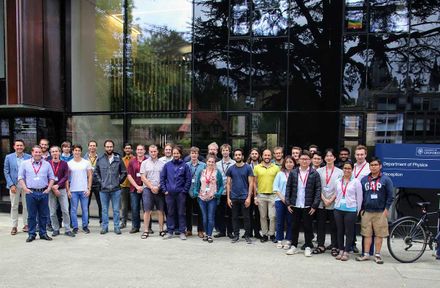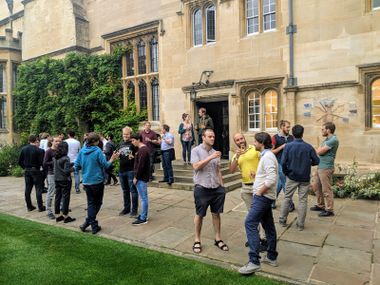OxDNA users and developers workshop 2019: Difference between revisions
No edit summary |
m (Louis moved page OxDNA users and developers workshop to OxDNA users and developers workshop 2019: new) |
||
| (76 intermediate revisions by one other user not shown) | |||
| Line 1: | Line 1: | ||
We are planning to hold an oxDNA users and developers workshop in Oxford from September 2-5 2019. | We are planning to hold an oxDNA users and developers workshop in Oxford from September 2-5 2019. | ||
The aim of the workshop is to bring together both developers and users of the oxDNA | The aim of the workshop is to bring together both developers and users of the oxDNA and oxRNA models not only to share current research projects, | ||
but also to set the agenda for the future development of the oxDNA | but also to set the agenda for the future development of the oxDNA and oxRNA models, code and infrastructure, as well as to identify (and begin to address) current | ||
shortcomings. Particular foci are likely to be inter-operability of DNA design and simulation tools, user-friendly tools to improve oxDNA accessibility for non-expert users. | shortcomings. Particular foci are likely to be inter-operability of DNA design and simulation tools, user-friendly tools to improve oxDNA accessibility for non-expert users. | ||
==Location== | ===Location=== | ||
[https://www2.physics.ox.ac.uk/the-beecroft-building Beecroft Building], Department of Physics, University of Oxford. | [https://www2.physics.ox.ac.uk/the-beecroft-building Beecroft Building], Department of Physics, University of Oxford ([https://goo.gl/maps/U61yvrBi1Zn9VKBr7 map]). | ||
<div style="text-align:left"> | <div style="text-align:left"> | ||
[[Image:Beecroft2.jpg|440px]] [[Image:Beecroft3.jpg|520px]] | [[Image:Beecroft2.jpg|440px]] [[Image:Beecroft3.jpg|520px]] [[Image:Beecroft7.jpg|162px]] | ||
</div> | </div> | ||
==Schedule== | ===Schedule=== | ||
Monday, Tuesday am: Short research presentations from all attendees | All attendees are welcome to give a short research presentation as part of the workshop. | ||
Monday, Tuesday am: Short research presentations from all/most attendees. These will help to highlight the range of work for which | |||
oxDNA is being used, tools that have been developed, and wish lists for future development. | oxDNA is being used, tools that have been developed, and wish lists for future development. | ||
| Line 24: | Line 26: | ||
Users to get help in utilizing more advanced code features. | Users to get help in utilizing more advanced code features. | ||
There are no registration fees. There will be a workshop dinner | The programme is now available | ||
[http://doye.chem.ox.ac.uk/abstracts/oxDNA_programme.pdf here] | |||
===Registration=== | |||
There are no registration fees. There will be a workshop dinner on Tuesday 3 September at Jesus College, and a wine-tasting event led by Domen Prešern on Wednesday 4 September at 8pm at Ard's home. There will also be the possibility to go on a Tolkien tour of Oxford led by Megan Engel. | |||
===Accommodation options=== | |||
A number of rooms (not en suite) have been reserved at [http://www.queens.ox.ac.uk The Queen's College] on their main site. These would cost £57.60 per night. These rooms can be booked [https://www.queens.ox.ac.uk/bed-breakfast here]. To access these rooms the code DOYE2019 needs to be entered before selecting the dates. | |||
Bed and breakfast rooms at other colleges can be booked [http://conference-oxford.com/bb-self-catering here]. | |||
===Travel=== | |||
The closest airport to Oxford is Heathrow, and the quickest transport from Heathrow airport to Oxford is via [https://airline.oxfordbus.co.uk/ coach]. More travel information can be found [https://www2.physics.ox.ac.uk/contacts/how-to-find-us here]. | |||
===Sponsors=== | |||
We are grateful for support from the [https://innovation.ox.ac.uk/award-details/john-fell-fund/ John Fell Fund]. | |||
===Attendees=== | |||
Matteo Becchi, SISSA Trieste | |||
Erik Benson, University of Oxford; Evolutionary refinement of DNA nanostructures using coarse-grained molecular dynamics simulations | |||
Joakim Bohlin, University of Oxford | |||
Keitel Cervantes-Salguero, Queen Mary University of London | |||
Hemani Chhabra, University of Oxford | |||
Lorenzo Di Michele, University of Cambridge | |||
Jonathan Doye, University of Oxford | |||
Megan Engel, Harvard University; Internal forces in oxDNA | |||
Hannah Fowler, University of Oxford | |||
Oliver Henrich, University of Strathclyde; Using oxDNA in the LAMMPS code | |||
Sieun Jung, Korea University | |||
Fabian Kohler, Technische Universität München; Cryo-EM Studies of Multilayer DNA Origami Objects | |||
Maximilian Nicolas Honemann, TU Munich | |||
Will Kaufhold, University of Cambridge; Rapid in silico prototyping of proximity sensitive DNA nanostructures | |||
Jaewon Lee, Korea University | |||
Ard Louis, University of Oxford | |||
Christopher Maffeo, University of Illinois; A Python framework for multi-resolution modeling of nanoscale DNA objects | |||
Michael Matthies, Arizona State University; General-Purpose analysis package for coarse-grained simulations of DNA/RNA nanotechnology | |||
Behnam Najafi, University of Oxford; Characterising DNA T-motifs | |||
Thomas Ouldridge, Imperial College; Non-equilibrium information processing: modelling with oxDNA | |||
Matthew Patitz, University of Arkansas; A web-based front end for oxDNA | |||
SungHun Park, Korea University | |||
Domen Prešern, University of Oxford | |||
Ferdinando Randisi, FarbricNano; FabricNano: a DNA-nanotech/bio-catalysis startup | |||
Flavio Romano, Universitá Ca Foscari di Venezia | |||
Lorenzo Rovigatti, Sapienza Universitá di Roma | |||
Michael Selby, University of Oxford | |||
Rahul Sharma, École polytechnique fédérale de Lausanne; The cgDNA family of coarse grain models of DNA: cgDNA+, cgDNAweb, and cgDNAmc | |||
Enrico Skoruppa, KU Leuven; Torsional properties of DNA | |||
Petr Šulc, Arizona State University; Towards simulations and design of large DNA/RNA systems with oxDNA/oxRNA | |||
Antonio Suma, University of Bari / Temple University, Accessibility of endonuclease to DNA origami: role of local and global fluctuations | |||
Jiaming Yu, University of Cambridge, Numerical Study on the Effect of Flexibility in DNA Building Blocks | |||
[[Image:oxDNAworkshop.jpeg|440px]] [[Image:oxDNAworkshop_Jesus.jpeg|380px]] [[Image:oxDNAworkshop_dinner.jpeg|215px]] | |||
===Remote participants=== | |||
Carlos Castro, Ohio State University; Design Automation for DNA Origami Mechanisms | |||
Elisa de Llano, Austrian Institute of Technology; Adenita: Customizable modeling and visualization of DNA nanostructures | |||
__NOTOC__ | |||
Latest revision as of 13:01, 25 April 2024
We are planning to hold an oxDNA users and developers workshop in Oxford from September 2-5 2019. The aim of the workshop is to bring together both developers and users of the oxDNA and oxRNA models not only to share current research projects, but also to set the agenda for the future development of the oxDNA and oxRNA models, code and infrastructure, as well as to identify (and begin to address) current shortcomings. Particular foci are likely to be inter-operability of DNA design and simulation tools, user-friendly tools to improve oxDNA accessibility for non-expert users.
Location
Beecroft Building, Department of Physics, University of Oxford (map).
Schedule
All attendees are welcome to give a short research presentation as part of the workshop.
Monday, Tuesday am: Short research presentations from all/most attendees. These will help to highlight the range of work for which oxDNA is being used, tools that have been developed, and wish lists for future development.
Tuesday pm: Discussion-based sessions to define the agenda for future development and to identify key targets and outline plans for implementation.
Wednesday, Thursday: "Hackathon": Begin to address the simpler targets (e.g. improve documentation of newer features, incorporation of existing external utilities into oxDNA infrastructure, develop and test simpler utilities). Make detailed plans for future development and collaborations. Users to get help in utilizing more advanced code features.
The programme is now available here
Registration
There are no registration fees. There will be a workshop dinner on Tuesday 3 September at Jesus College, and a wine-tasting event led by Domen Prešern on Wednesday 4 September at 8pm at Ard's home. There will also be the possibility to go on a Tolkien tour of Oxford led by Megan Engel.
Accommodation options
A number of rooms (not en suite) have been reserved at The Queen's College on their main site. These would cost £57.60 per night. These rooms can be booked here. To access these rooms the code DOYE2019 needs to be entered before selecting the dates.
Bed and breakfast rooms at other colleges can be booked here.
Travel
The closest airport to Oxford is Heathrow, and the quickest transport from Heathrow airport to Oxford is via coach. More travel information can be found here.
Sponsors
We are grateful for support from the John Fell Fund.
Attendees
Matteo Becchi, SISSA Trieste
Erik Benson, University of Oxford; Evolutionary refinement of DNA nanostructures using coarse-grained molecular dynamics simulations
Joakim Bohlin, University of Oxford
Keitel Cervantes-Salguero, Queen Mary University of London
Hemani Chhabra, University of Oxford
Lorenzo Di Michele, University of Cambridge
Jonathan Doye, University of Oxford
Megan Engel, Harvard University; Internal forces in oxDNA
Hannah Fowler, University of Oxford
Oliver Henrich, University of Strathclyde; Using oxDNA in the LAMMPS code
Sieun Jung, Korea University
Fabian Kohler, Technische Universität München; Cryo-EM Studies of Multilayer DNA Origami Objects
Maximilian Nicolas Honemann, TU Munich
Will Kaufhold, University of Cambridge; Rapid in silico prototyping of proximity sensitive DNA nanostructures
Jaewon Lee, Korea University
Ard Louis, University of Oxford
Christopher Maffeo, University of Illinois; A Python framework for multi-resolution modeling of nanoscale DNA objects
Michael Matthies, Arizona State University; General-Purpose analysis package for coarse-grained simulations of DNA/RNA nanotechnology
Behnam Najafi, University of Oxford; Characterising DNA T-motifs
Thomas Ouldridge, Imperial College; Non-equilibrium information processing: modelling with oxDNA
Matthew Patitz, University of Arkansas; A web-based front end for oxDNA
SungHun Park, Korea University
Domen Prešern, University of Oxford
Ferdinando Randisi, FarbricNano; FabricNano: a DNA-nanotech/bio-catalysis startup
Flavio Romano, Universitá Ca Foscari di Venezia
Lorenzo Rovigatti, Sapienza Universitá di Roma
Michael Selby, University of Oxford
Rahul Sharma, École polytechnique fédérale de Lausanne; The cgDNA family of coarse grain models of DNA: cgDNA+, cgDNAweb, and cgDNAmc
Enrico Skoruppa, KU Leuven; Torsional properties of DNA
Petr Šulc, Arizona State University; Towards simulations and design of large DNA/RNA systems with oxDNA/oxRNA
Antonio Suma, University of Bari / Temple University, Accessibility of endonuclease to DNA origami: role of local and global fluctuations
Jiaming Yu, University of Cambridge, Numerical Study on the Effect of Flexibility in DNA Building Blocks
Remote participants
Carlos Castro, Ohio State University; Design Automation for DNA Origami Mechanisms
Elisa de Llano, Austrian Institute of Technology; Adenita: Customizable modeling and visualization of DNA nanostructures





